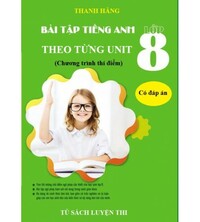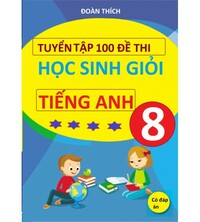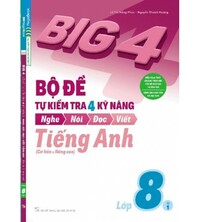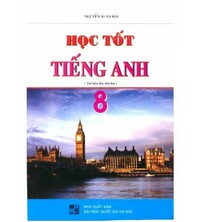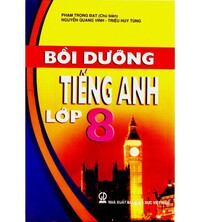Lesson 1 - Unit 8. Traditions of ethnic groups in Vietnam- SBT Tiếng Anh 8 iLearn Smart World
a. Complete the table and write the letters.b. Complete the crossword with the words from Task a. a. Read the article about Pu Péo people. Where would you see this article?b. Now, read and answer the questions.Underline the mistakes and write the correct words on the lines. Write “Ø” for zero article.
a
a. Complete the table and write the letters.
(Hoàn thành bảng và viết các chữ cái.)

Lời giải chi tiết:
1. pottery (đồ gốm)
2. cloth (vải)
3. silver (bạc)
4. ethnic (dân tộc)
5. pattern (hoa văn)
6. basket (rổ)
7. embroidery (thêu)
8. product (sản phẩm)
9. headscarf (khăn trùm đầu)
b
b. Complete the crossword with the words from Task a.
(Hoàn thành ô chữ với các từ trong Nhiệm vụ a.)

Down (Xuống)
1. People make jewelry by using this material. (Người ta làm đồ trang sức bằng vật liệu này.)
2. designs used yo make clothes and other things look nice (thiết kế được sử dụng để làm cho quần áo và những thứ khác trông đẹp mắt)
3. connected to a group of people with shared traditions (kết nối với một nhóm người có chung truyền thống)
4. a cloth that covers the head (khăn che đầu)
5. bowls and plates often made by hand (Bát, đĩa thường làm thủ công)
6. You can make clothes and other things with this material. (Bạn có thể làm quần áo và những thứ khác bằng vật liệu này.)
Across (Sang)
7. something people make or create, usually for sale (thứ mà mọi người chế tạo hoặc tạo ra, thường là để bán)
8. a design sewn onto clothes (một thiết kế may trên quần áo)
9. You can use this to carry things. (Bạn có thể dùng cái này để đựng đồ.)
Lời giải chi tiết:
1. silver (bạc)
2. pattern (hoa văn)
3. ethnic (dân tộc)
4. headscaft (khăm trùm đầu)
5. pottery (đồ gốm)
6. cloth (vải)
7. product (sản phẩm)
8. embroidery (thêu)
9. basket (rổ)
a
a. Read the article about Pu Péo people. Where would you see this article?
(Đọc bài viết về người Pu Péo. Bạn sẽ thấy bài viết này ở đâu?)
1. a travel website (một trang web du lịch)
2. a dictionary (một từ điển)
3. a fashion magazine (một tạp chí thời trang)
The Pu Péo are an ethnic group in Vietnam and China. Their population is around 900 people (2019). They mainly live in Hà Giang Province in Vietnam and Yunnan Province in China. They make lots of interesting products.
Pu Péo women wear beautiful traditional clothes. They wear a long skirt, a headscaft, and two different vests. Most of their clothes are black. They often make amazing, colorful patterns using embroidery or by sewing small pieces of cloth on their clothes. Many Pu Péo women also wear silver rings. Pu Péo men usually wear simple shirts and pants. Pu Péo men are very good at making crafts. They make very good furniture out of wood. Pu Péo women sew and make embroidery. The Pu Péo people grow rice, beans, and other vegetables on their farms. They use animals to help them on the farm. They usually eat a simple diet of rice, meat and vegetables.
Tạm dịch:
Người Pu Péo là một dân tộc ở Việt Nam và Trung Quốc. Dân số của họ là khoảng 900 người (2019). Họ chủ yếu sống ở tỉnh Hà Giang Việt Nam và tỉnh Vân Nam Trung Quốc. Họ tạo ra rất nhiều sản phẩm thú vị.
Phụ nữ Pu Péo mặc trang phục truyền thống rất đẹp. Họ mặc một chiếc váy dài, khăn trùm đầu và hai chiếc áo vest khác nhau. Hầu hết quần áo của họ là màu đen. Họ thường tạo ra những mẫu đầy màu sắc, tuyệt vời bằng cách thêu hoặc khâu những mảnh vải nhỏ trên quần áo của họ. Nhiều phụ nữ Pu Péo còn đeo vòng bạc. Đàn ông Pu Péo thường mặc áo sơ mi và quần đơn giản. Đàn ông Pu Péo làm đồ thủ công rất giỏi. Họ làm đồ đạc rất tốt bằng gỗ. Phụ nữ Pu Péo may vá, thêu thùa. Người Pu Péo trồng lúa, đậu và các loại rau khác trong trang trại của họ. Họ sử dụng động vật để giúp họ trong trang trại. Họ thường ăn một chế độ đơn giản gồm cơm, thịt và rau.
Lời giải chi tiết:
1. a travel website (một trang web du lịch)
b
b. Now, read and answer the questions.
(Bây giờ, hãy đọc và trả lời các câu hỏi.)
1. What is the population of Pu Péo people in 2019? (Dân số của người Pu Péo năm 2019 là bao nhiêu?)
_______________________________________________________________
2. What color are most Pu Péo women’s clothes? (Trang phục của phụ nữ Pu Péo thường có màu gì?)
_______________________________________________________________
3. What crafts do Pu Péo men make? (Đàn ông Pu Péo làm những nghề thủ công gì?)
_______________________________________________________________
4. What do Pu Péo people grow on their farms? (Người Pu Péo trồng gì trong trang trại của họ?)
_______________________________________________________________
5. What do Pu Péo people eat? (Người Pu Péo ăn gì?)
___________________________________________________________
Lời giải chi tiết:
1. The population of Pu Péo people in 2019 is around 900 people.
(Dân số của người Pu Péo năm 2019 khoảng 900 người.)
Thông tin: The Pu Péo are an ethnic group in Vietnam and China. Their population is around 900 people (2019).
(Người Pu Péo là một dân tộc ở Việt Nam và Trung Quốc. Dân số của họ là khoảng 900 người (2019).)
2. Most Pu Péo women’s clothes are black.
(Hầu hết trang phục của phụ nữ Pu Péo là màu đen.)
Thông tin: Pu Péo women wear beautiful traditional clothes. They wear a long skirt, a headscaft, and two different vests. Most of their clothes are black.
(Phụ nữ Pu Péo mặc trang phục truyền thống rất đẹp. Họ mặc một chiếc váy dài, khăn trùm đầu và hai chiếc áo vest khác nhau. Hầu hết quần áo của họ là màu đen.)
3. Pu Péo men make furniture.
(Đàn ông Pu Péo làm đồ đạc.)
Thông tin: Pu Péo men are very good at making crafts. They make very good furniture out of wood.
(Đàn ông Pu Péo làm đồ thủ công rất giỏi. Họ làm đồ đạc rất tốt bằng gỗ.)
4. Pu Péo people grow rice, beans, and other vegetables on their farms.
(Người Pu Péo trồng lúa, đậu và các loại rau khác trong trang trại của họ.)
Thông tin: The Pu Péo people grow rice, beans, and other vegetables on their farms.
(Người Pu Péo trồng lúa, đậu và các loại rau khác trong trang trại của họ.)
5. Pu Péo people eat rice, meat, and vegetables.
(Người Pu Péo ăn cơm, thịt và rau.)
Thông tin: They usually eat a simple diet of rice, meat and vegetables.
(Họ thường ăn một chế độ đơn giản gồm cơm, thịt và rau.)
Grammar
Underline the mistakes and write the correct words on the lines. Write “Ø” for zero article.
(Gạch chân những lỗi sai và viết những từ đúng vào các dòng. Viết “Ø” cho mạo từ không.

Lời giải chi tiết:

1. The Khmer people mainly live in Cambodia.
(Người Khơ-me chủ yếu sống ở Campuchia.)
2. The Nùng people have a large collection of folk songs.
(Dân tộc Nùng có một kho tàng dân ca khá phong phú.)
3. A Red Dao man usually wears pants, a shirt, and a red headscarf.
(Đàn ông Dao đỏ thường mặc quần, áo sơ mi và chít khăn đỏ.)
4. After getting married, the men live with their wives’ families.
(Sau khi kết hôn, nam giới về ở với gia đình vợ.)
5. The men do the cooking on the first day of the new year.
(Những người đàn ông nấu ăn vào ngày đầu tiên của năm mới.)
Writing
Write six sentences using each article (a, an, the, and zero article) about ethnic groups in Vietnam. Use the information in the Student’s Book to help you. Write 80 to 100 words.
(Viết sáu câu sử dụng mỗi mạo từ (a, an, the, và zero mạo từ) về các dân tộc ở Việt Nam. Sử dụng thông tin trong Sổ học sinh để giúp bạn. Viết 80 đến 100 từ.)
Lời giải chi tiết:
1. Cham people traditionally weave beautiful textiles in bold pinks or blues, which are saved for important rituals and ceremonies.
(Người Chăm thường dệt những loại vải đẹp có màu hồng đậm hoặc xanh dương, được cất giữ để mặc vào những nghi lễ hoặc những dịp quan trọng.)
2. Ede women traditional custome includes a shirt is a boatneck with full sleeves and a sarong wrapped as a skirt.
(Trang phục truyền thống của phụ nữ Ê Đê bao gồm chiếc áo dài tay cổ thuyền và một chiếc xà rông quấn lại làm váy.)
3. Cham people's dress is mostly made from cotton in white or blue, with a sarong for both men and women.
(Trang phục của người CHăm hầu hết đều được làm từ vải cốt-tông màu trắng hoặc xanh biển, với vày xà rông cho cả nam và nữ.)
4. New Year is an important festival for the Khmer people. (Năm mới là lễ hội quan trọng của người Khmer.)
5. The Black H'mong are a subgroup of the H’mong minority, and usually make their homes in the mountainous areas of Northern Vietnam.
(Người H'mong đen là một nhóm nhỏ của dân tộc thiểu số H'mong, và họ thường sinh sống ở vùng núi phía bắc Việt Nam.)
6. The Chăm people mainly live in Central and Southern Vietnam.
(Người Chăm sống chủ yếu ở Trung Bộ và Nam Bộ.)
Search google: "từ khóa + timdapan.com" Ví dụ: "Lesson 1 - Unit 8. Traditions of ethnic groups in Vietnam- SBT Tiếng Anh 8 iLearn Smart World timdapan.com"


